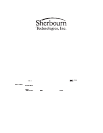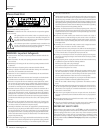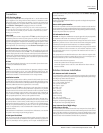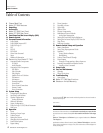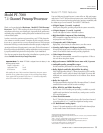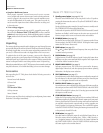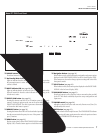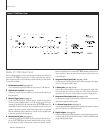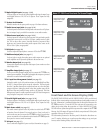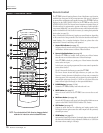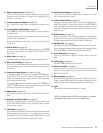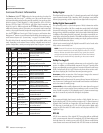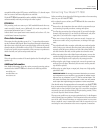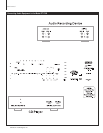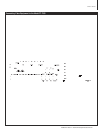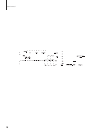
2
Oa Ad
Owner’s Manual
Model PT-7000 7.1 Channel Preamp/Processor/Tuner
Owner’s Manual
Precautions
Verify The Line Voltage
Your new Model PT-7000 has been factory congured for 120 (+/- 3%) volt AC lines. Connect-
ing the amplier to a line voltage other than that for which it is intended can create a
safety and re hazard, and may damage the amplier. If you have any questions about
the voltage requirements for your specic model, or about the line voltage in your area,
contact Sherbourn Technologies before plugging the unit into a wall outlet.
NOTE: It is always a good idea to avoid using any audio or video equipment on
the same AC circuit as equipment with motors, such as air conditioners or refrigera-
tors. This will lessen the possibility of power variation and electrical start-up noise
affecting your sound system.
Power Cord
The removable power cord that is shipped with the PT-7000 is specically designed to be
used with this product. DO NOT use any other power cord, as that may reduce the unit’s
performance and possibly create a safety hazard. In particular, DO NOT use standard IEC
type power cords designed for computers and other business equipment products, as they
have a three prong plug that is not meant for use with the PT-7000. Should the power cord
require replacement, use an identical type, or contact Sherbourn Technologies for service.
Handle the AC Power Cord Gently
When disconnecting the power cord from an AC outlet, always pull the plug, never pull
the cord. If you do not intend to use the PT-7000 for any considerable length of time,
disconnect the plug from the AC outlet. If the power cord is replaced, make certain that it is
of similar gauge. As with all electrical devices, do not run power cords under rugs or carpets
or place heavy objects on them. Damaged power cords should be replaced immediately
with cords meeting factory specications.
AC Fuse
The fuse is located inside the chassis and is not user-serviceable. If power does not come
on, contact your authorized service station.
Wiring
Cables that are run inside of walls should have the appropriate markings to indicate
complaince with, and listing by the UL , CSA or other standards required by the UL, CSA,
NEC or your local building. Questions about cables inside of walls should be referred to a
qualied custom installer, or a licensed electrician or low-voltage contractor.
Installation Location
To assure proper operation and to avoid the potential for safety hazards, place the unit
on a rm and level surface capable of supporting it’s weight. When placing the unit on a
shelf, be certain that the shelf and any mounting hardware can support the weight of the
unit and any additional items in the equipment rack, or on the shelf.
When positioning the PT-7000 in its nal location, make certain that it has adequate
ventilation on all sides, as well as on the top and bottom. In particular, it is a good idea
to provide at least two or three inches of room above the unit for air circulation. DO NOT
place CDs, DVDs, videotapes, owner’s manuals, or other paper on top of, or beneath, the
unit, or in-between multiple ampliers in a stack. This will block airow, causing heat
build-up, degraded performance, and may create a possible re hazard.
If the unit is to be enclosed in a cabinet or rack, make certain there is adequate air cir-
culation. Sufcient ventilation should be provided so that hot air may exit, and cool air
may enter the cabinet. In some instances, a small cooling fan may be required to insure
adequate airow through the cabinet. If you are in doubt as to the ventilation require-
ments for your specic installation, please contact us. Also, do not place the PT-7000
directly on a carpeted surface, as this will inhibit airow underneath as well as create a
potential re hazard.
Avoid installation in humid locations, in extremely hot or cold locations, or in areas that
are exposed to direct sunlight or space heating equipment.
Do Not Open The Cabinet
There are no user serviceable components inside this product. Opening the cabinet may
present a shock hazard, and any modication to the product will void your guarantee. If
water or any metal object, such as a paper clip, coin or a staple, accidentally falls inside
the unit, disconnect it from the AC power source immediately, and contact Sherbourn Technologies
for further instructions.
Recording Copyright
Recording of copyrighted material for other than personal use is illegal without permission
of the copyright holder.
Note to CATV system installer
This reminder is provided to call the CATV system installer’s attention to Article 820-40 of
the NEC, ANSI/NFPA 70, which provides guidelines for proper grounding and, in particular,
species that the cable ground shall be connected to the grounding system of the building,
as close to the point of cable entry as practical.
FCC Information for User
CAUTION: ANY changes or modications not expressly approved by the party responsible
for compliance could void the user’s authority to operate the equipment.
NOTE: This equipment has been tested and found to comply with the limits for a Class B
digital device, pursuant to Part 15 of the FCC Rules. These limits are designed to provide
reasonable protection against harmful interference in a residential installation.
This equipment generates, uses and can radiate radio frequency energy and, if not installed
and used in accordance with the instructions, may cause harmful interference to radio
communications. However, there is no guarantee that interference will not occur in a
particular installation.
If this equipment does cause harmful interference to radio or television reception, which
can be determined by turning the equipment off and on, the user is encouraged to try to
correct the interference by one or more of the following measures:
Reorient or relocate the receiving antenna.
Increase the separation between the equipment and receiver.
Connect the equipment into an outlet on a circuit different from that to which the
receiver is connected.
Outdoor Antenna Installation
Safe Antenna and cable Connection
If an outside antenna or cable system is connected to the equipment, be sure the antenna
or cable system is grounded so as to provide some protection against built up static charges
and voltage surges. Section 810 of the national
Electrical Code, ANSI/NFPA 70 (in Canada,
part 1 of the Canadian Electrical
Code) provides information
with respect to proper
grounding of the
mast and sup-
porting structure,
grounding of the
lead-in wire to an
antenna discharge
unit, size of grounding
conductors, location of antenna dis-
charge unit, connection to grounding electrodes
and requirements for the grounding electrode.
Keep Antenna Clear of High Voltage
Power Lines or Circuits
An outside antenna system should be located well away from power lines, electric light or
power circuits and where it will never come into contact with these power sources if it should
happen to fall. When installing an outside antenna, extreme care should be taken to avoid
touching popwer lines, circuits or other power sources as this could be fatal. Because of the
hazards involved, antenna installation should be left to a professional.
Precautions
3



